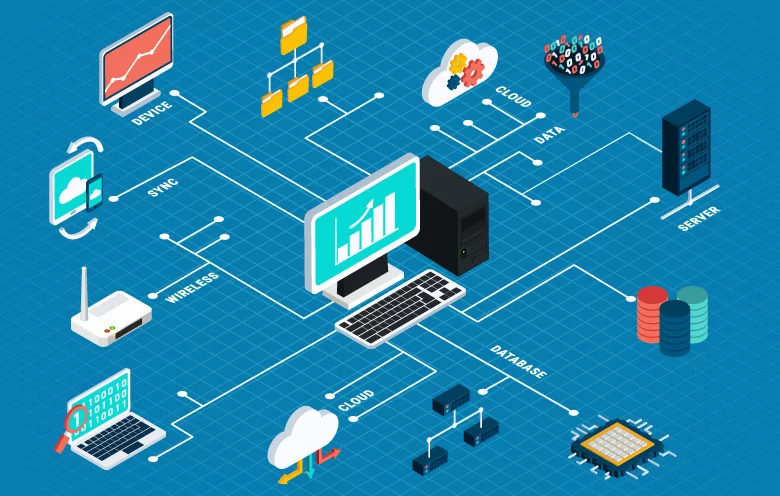In the wake of COVID-19-led slowdown, businesses across different segments of the tech industry are undergoing enormous pressure to manage the logistics of remote working. However, amid this time of crisis, the tailwinds of cloud-based digitization are turning out to be more powerful than the headwinds of macro-economic forces, which lead companies to embark on the digital journey.
Moreover, enterprises that have gone far along in their digital transformation journeys are de facto, functioning more smoothly and effectively than the ones with bare minimum digital assets or are yet to evolve digitally. This motivates businesses to build powerful digital capabilities, cloud-based infrastructure and remote tools for strong lines of communication.
“The managed services market is anticipated to be a whopping worth of 356.24 billion by 2025.”
Statista
To ascertain a smooth transition to a digital work culture and cloud migration, it is critical to handle today’s IT demand, including troubleshooting and maintenance. This is where managed services (MS) comes into the picture.
Whether you are looking to get into managed services or have already taken the plunge but not happy about it, this blog post offers you some highly instructive directions to make a successful move towards dynamic managed services for a wide array of traditional and cloud infrastructure.
What are the different types of managed services?
Before making the leap to managed services and transform your business, you must understand various kinds of managed services. Then, based on your organization’s IT needs, you can either choose a single IT service or opt for an integrated suite of services. The different forms of advanced managed services are:
1. Business intelligence and data analytics
2. Managed networks and infrastructure
3. Managed Software-as-a-Service (SaaS)
4. Managed cloud infrastructure
5. Managed remote monitoring
6. Managed centralized communications
7. Managed mobile computing
8. Managed security services
9. Managed support services
10. Managed hosting and storage
What are the most common roadblocks to managed services’ success?
You do not require a crystal ball to know how successful your managed services journey would be. Because, to fast-track your managed services’ success, all you need to do is avoid some standard pitfalls and scale your IT managed services as per the needs of your business. Let us have a look at some common roadblocks to the success of managed services:
- Lack of centralized control and monitoring
- Reactive technical issue
- Substandard lines of communication
- Inconsistent execution
- Getting bogged down by technology
- Lack of automation
- Macro-economic landscape
- Lack of visibility and control
Six steps to the success of managed services
1. Preparing for the transition
Amid the ongoing pandemic, most companies have transitioned to remote work and have adopted advanced technology to react to the response, but how prepared is your organization for the transition? For smoothly transitioning to virtual work culture while ensuring your business’ operations continues seamlessly; a range of managed service capabilities are available in the market, including mobility, collaboration, data storage and deployment. And to embrace these modern-day services, all you need to do is prepare for the transition.
2. Formulating a well-defined MS strategy
Having the right MS strategy is critical to the success of managed services within your organization. And to formulate a well-defined, documented MS strategy, you need to create a robust business model, conduct an assessment and know the answers of the following questions:
- What devices do you have and how many devices are currently managed?
- If you have migrated to the cloud, then how will you manage your cloud services?
- Are you willing to substitute your on-premises server management with virtual storage?
- Whether your business requires a full suite of integrated managed cloud service?
- Do you have automated remote monitoring and management tools?
3. Choosing the right tools and technology
To deliver successful managed services within your organization, it is crucial to select the right tools and technologies as per your business’ requirements. In the current scenario, no architecture or tool can be a silver-bullet, but an amalgamation of few architectures or tools can offer robust functionality, scalability and power while handling a high-level of managed services. Let us have a closer look at the benefits and impact of certain features of new-age tools:
| Features | Benefits | Business Impacts | ||
|---|---|---|---|---|
| Remote | Faster and easier troubleshooting | Efficient service delivery, advanced endpoint protection, pro-active maintenance | ||
| Scalable | Highly customizable infrastructure | Stay agile all the way and grow quickly as the market dominates | ||
| Automated | Annihilate tediousness, redundant administration | Reduces management complexities and human errors | ||
| Comprehensive | Quality service delivery throughout the extent | Address monitoring, continuity, cloud and security needs | ||
| Light-weight | Reduced overall machine and network spaces | No deterioration of performance | ||
| Accessible | Ubiquitous and highly secure | Can manage machines from anywhere |
4. Get your head in the clouds
In the digital era, it is significant for businesses to take their IT services over the cloud and operate it remotely. But to optimize the adoption of advanced cloud-based tools for managed services, you should have an in-depth understanding of the technical barriers, customize the right solutions and migrate your systems to the cloud. However, a majority of IT managed service offerings are delivered virtually by top-of-the-line managed service providers (MSP) over the cloud. By contacting the right MSP, you can also leverage next-generation managed cloud services.
5. Automation – the key to efficiency
Automation is the secret sauce for delivering managed IT services within an organization. However, the competence of your business operations or tasks can be gauged by the number of IT services automated using new-age remote monitoring and management (RMM) tools/technology. The more amount of daily operations or services you automate; the less time you invest in reinventing the wheel. But to automate your routine services, you must seek assistance from the right provider to implement the right automation tools, practices and processes.
6. Security must be the topmost priority
In this time of crisis, it is extremely important to enhance the security of IT infrastructure. Hence, for improved data security and round-the-clock IT management, security becomes the topmost priority. And for that, you need to figure out what measures to take and which processes are in place that will safeguard your data, network, or machine against security breaches. Consequently, along with adequate cloud network and storage, your IT infrastructure also needs adequate security.
Embrace, survive and thrive: Advantages of managed services
Managed services offer several advantages to modern businesses, which includes:
- High scalability
- Reduced operational costs
- Pay-as-you-use model
- Reduced risks
- Continuous updates and upgrades
- Future-proof remote services
- Secure, resilient infrastructure
- Centralized cloud-based data centers
- Business continuity and disaster recovery
- Ease of upgrading/downgrading the system
- Elimination of expensive downtime
- Comprehensive reporting
- Advanced security
Keep your business moving amid the crisis, and beyond
In the era of digitization, the IT industry is evolving at a dramatic pace, driven by automation and collaboration tools, technologies and security applications. Also, to stay ahead of the pack in the digital age, your business needs to gain the benefits of modern technology to get the most out of your IT infrastructure. But, the technology industry is plagued with tons of managed service providers, and you need to choose the right MSP to achieve victory fighting against COVID-19 on the battlefield and keep your business moving amid the chaos.
If you are seeking for advanced digital capabilities to make your business resilient to the current crisis and ensure business continuity, get in touch with our team of experts.








